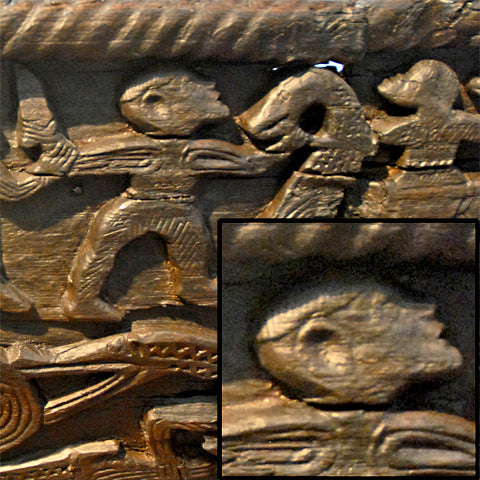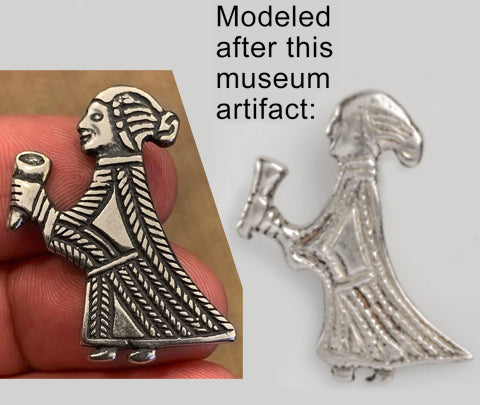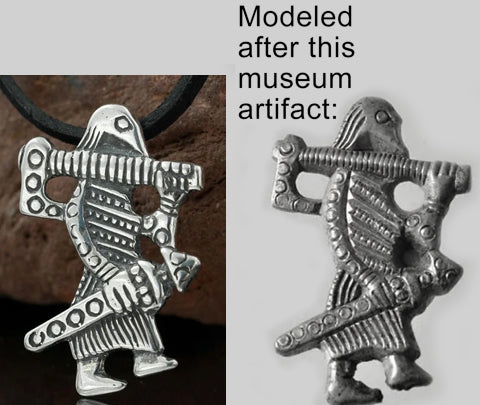Thanks for visiting our blog! As a thank-you, enjoy 15% off your first order in our online Viking Shop with the discount code BLOG15.
Vikings came from an honor culture where individuals expressed their worth through actions, words, and appearance. Abundant jewelry, clothing, combs, and personal care items recovered by archaeologists show that personal presentation was of great importance in Viking societies. But while the Viking preoccupation with hair and grooming are well established, what their hair styles actually looked like is a surprisingly controversial topic. Since Vikings only left cremated or skeletal remains, and since the written material from the era is almost always sparse in detail, how can we really know what Vikings looked like? This article will examine the surviving evidence from the literary and archaeological record to render a more accurate portrait of the Viking hairstyles of 1000 years ago. And as we will cover below, these various accounts range from short hair to long hair, beardless to bearded, full head of hair to partially shaved heads.
The Viking Age (793-1066; or 750-1050, if you like the less Anglo-centric numbers) lasted around 300 years. Vikings traveled through what are now 40 different countries and interacted with 50 world cultures. At the apex of their influence, Vikings could be found from Newfoundland to Western Asia. Their trade networks were extensive, with goods and ideas passing between intrepid travelers over vast distances. There is strong historical and archaeological evidence that Vikings absorbed fashion and other material and intellectual properties from the peoples they interacted with and spread them to new peoples. Because of the Vikings, fashion trends from the east were felt in the west, and vice versa.
Because of this, when one speaks of “Viking hair style” it is foolish to think that this is a narrow spectrum of styles that never changed. To think that Vikings only had short hair or long hair, bowl cuts or “reverse mullets,” full beards or just mustaches or were clean shaven would all be a drastic oversimplification. Similarly, it is not on the side of accuracy to say “Vikings never had that hair style” when hundreds of thousands of Vikings lived over 10-15 generations throughout an immense spread around the world. Vikings were a varied and curious people who did not like to be limited.
Women’s Hair
In Viking society, women wore their hair long as a sign of status and to be appreciated for its beauty. Naturally, these hard-working women tied their hair back, braided it, or wore it up to keep it out of their way while they worked the loom or performed their other daily tasks. Sculptures, carvings, and other art show women wearing their hair long in the back, while the long locks of the front and sides are worn up in a bun or braided in a knot.
Below is a reproduction pictured next to to the original Viking artifact depicting women’s hairstyles during that time:
And below is a 9th century artifact found in Revninge, Denmark which appears to show a woman with long hair knotted or in a bun at the back of the head.
And below is yet another Viking age artifact which appears to be a Valkyrie holding a drinking horn, with her hair in a bun:
The Eddic poem Rigsthula mentions both jarl (upper class) and karl (the land-owning “middle class” that made up most Vikings) women wearing head dresses or bonnets. In the Oxford translation, the karl woman’s head dress is referred to as a “curved cap.” Such bonnets have survived in archaeology. This “curved” style is called a Jorvik (York) cap, while a simpler, more angular style is known as a Dublin cap. These caps or head dresses were commonly made of linen, with wool perhaps being used in the colder months.
Then as now, richer women had nicer hats. Here, a pair of archaeological discoveries speak a thousand words: a finely made woman’s cap from Viking Age York and another from Lincoln (about 55 miles apart in the Viking occupied Danelaw of England) were produced from the same bolt of silk. This bolt of silk had come all the way from the Far East, changing hands from one Viking to another across the river systems of Europe. This is a testament both to the Vikings’ far-reaching trade networks, and the importance they placed on fashion.
Proud as Viking women were of their locks, it was Viking men that were the most preoccupied with hair. Here we see a wide range of hair styles and beard grooming, as men tried to set themselves apart from each other and boast their status and worth.
Did Viking Men have Long Hair or Short?
Numerous Roman writers comment on the long hair of “Northern barbarians,” but did the Vikings still wear their hair long like their ancestors (and the neighbors of their ancestors) did? In the Grágás medieval law codes of Iceland, there is the rule that women should not wear their hair short “like a man’s,” but “short” and “long” are always relative terms. In many ways, short hair is more practical for men on the move – one of the main reasons why most armed forces today insist on short hair. So, for insight into the question of Viking men’s hair length, we must rely on the artistic record.
Below is a period artifact showing a Viking warrior with long hair and a possible pointed goatee:
In the carvings and other art of the Vikings, or the art of others portraying them, we see a range of hair lengths. An easy illustration of this is in the Isle of Lewis chess pieces, where we see the king with long plaited hair, the warriors have shoulder length straight hair, and the bishop only wears his hair to the nape of his neck.
Another illustration is the carving found on a wooden wagon that was part of the Oseberg ship burial. This particular scene shows men in battle – one apparently with short hair on top of his head but not on the sides or back. While some may argue this might represent a wool cap he was wearing, there are similar hair styles found on the Bayeux Tapestry.

The 11th century color plaits by English artists portraying the Great Heathen Army of two centuries before show most Vikings having short hair. The artists could not have known what the Vikings of the late 9th century had looked like (except from oral tradition, now lost) but would have been acquainted with Vikings of their own day. Again, notice the range of bearded and non-bearded faces.

The 230 foot long Bayeux Tapestry (small portion seen below), was reportedly woven by Matilda, the wife of William the Conqueror and her ladies to commemorate the dramatic events of 1066 show a number of Vikings. This amazing artifact is believed to be from the 11th century, made just a few years after the famous battle of Hastings. In this particular account, most of the Vikings are shown with short hair, various hair colors and some possibly having the back of their heads shaved (note the second man from the right). 
So, once more, the picture that emerges is one of considerable variety in hair length and style. But in almost every case, there is the predisposition towards grooming and deliberate personal presentation, whether that hair be long or short.
Shaved and Partially Shaved Heads?
One of the rare written accounts of Viking hair styles comes from a surviving letter from one Englishman to his brother, upbraiding him for his adoption of Viking clothing and hair. “You dress yourself in the Danish fashion, with bald neck and blinded eyes.” This “bald neck and blinded eyes” is taken by many to mean a hairstyle where the back is shaved but the top is long (perhaps even with long bangs).
Below is History Channel’s series Vikings attempts to recreate this Danish style:

Speculation aside, such a haircut appears both in the Oseberg Ship Burial and the Bayeux Tapestry. In the previously mentioned relief on the Oseberg Ship and in the scene below from the Bayeux Tapestry, we see a similar hair style.

But there is more. In the account of the treaty signing between the Byzantine Empire and the Viking Rus (of Kiev), Leo the Deacon describes the notorious Sviatoslav (Norse name, Sveinald and Grand Prince of the Rus) as having “shaved his head completely, except for a lock of hair on one side, denoting his rank.” This hairstyle sounds similar to what we see above, as well as a bit like the “Suebian knot” described by Roman writers of long before.
Sviatoslav's shaved head and side knot described in this passage support the premise that Vikings used razors, tweezers, and/or other means to mold their hair to however they wanted.
Below is a 19th century sculpture of Sviatoslav the Brave, based on the description by Leo the Deacon:

Did Viking Men Dye their Hair?
Some Viking soaps had a very high lye content. These soaps could bleach the hair and beard a platinum blonde (as well as annihilate any lice that might try their luck). Many experts are convinced that Vikings deliberately dyed their hair to achieve this desirable look (as well as conceal their age if they were lucky enough to live so long). However, since sources mention Vikings with other hair colors, such as red, brown, or black, it is safe to say that this practice was neither universal nor accidental.
Irish sources speak of competing groups of Vikings that fought it out for supremacy during the middle of the 9th century. These “Fair (or Light) Foreigners” and “Dark Foreigners” are usually thought to be Vikings from Norway and Denmark, respectively – though there are many other theories. Since Norwegian Vikings were not uniformly blonde any more than Danish Vikings were uniformly brown, the name could have arisen from one group’s prevalence of blondes and bleach-blondes juxtaposed to the other group's natural coloring. Of course, there are many other possibilities, and it is impossible to know.
Beards
Few things seem more synonymous with Vikings than beards! Of course, Vikings loved beards and were even known individually for their beards (such as Sygtrygg Silkenbeard and Sweyn Forkbeard). One of the kennings (poetic nicknames) for Thor was “Red Beard.” But not all Vikings grew their beards au naturel. In fact – some Vikings had no beards at all.
In one of the most popular Icelandic sagas (then and now), Njal’s Saga, the wise hero is slandered by his enemies for having no beard (with the insinuation that this casts doubt on his gender and sexuality). However, beardless Vikings are plentiful in both Norse and non-Norse art.
Vikings who had beards groomed them carefully. In the Eddic poem, Rigsthula, we read of the free-born landowner (the class that produced the most Vikings) “his beard was trimmed.” Similarly, in art we see beards trimmed and shaped. Sometimes we see goatees or even mustaches with no beard. It would appear that Vikings used as much freedom of expression in cultivating and grooming their facial hair as they did in everything else.
A figure from the Oseberg Ship Burial showing a figure with well-groomed hair, mustache, and beard:

Conclusion
As we have seen from the (very limited) written accounts and the few period artifacts we have to pull from, Viking hair styles varied from short hair to long braided hair, and sometimes included shaved on the side and possibly even bangs over their eyes. With nearly 300 years of Viking age history, including literally hundreds of thousands of Vikings who were each influenced by the dozens and dozens of different cultures they eventually blended with, it is impossible to say there was only one or two specific Viking hair styles. Enthusiasts who say that a particular hairstyle was never worn by the Vikings are overconfident considering the few available facts. Or they are letting the artistic liberties of popular Viking TV series or movies frustrate them too much.
We do know for certain, though, that Vikings were very deliberate with their appearance and quite proud of how they looked. Shortly after the Viking Age was kicked off with the infamous raid of Lindisfarne, the Anglo-Saxon bishop, Alcuin, included in his scathing letter to King Aethelred I of Northumbria:
“Look at the dress, the hairstyle, and the luxurious habits of the princes and people. Look at the hairstyle, how you have wished to imitate the pagans [Vikings] in their beards and hair! Does not the terror threaten of those whose hairstyle you wished to have?” (Price, 2020, p. 282).
Not only were the Vikings well-groomed and distinctive in appearance, but they were also known by this. Indeed, these qualities were admired (sometimes grudgingly) by the people they came in contact with. Of course, this was all part of the point. Appearance shows self-respect and conveys self-concept. The Vikings had these things in spades. It was part of who they were, and part of what made them so successful.
Sons of Vikings is an online store offering hundreds of Viking inspired items, including Viking jewelry, Viking clothing, home decor items and more.
To learn more about Viking history, we recommend our 400+ page, self titled book that is available here.
References
- Rodgers, D. & Noer, K. Sons of Vikings: History, Legends, and Impact of the Viking Age. KDP. The United States. 2018.
- Price, N. Children of Ash and Elm: A History of the Vikings. Basic Books, New York, 2020.
- The Poetic Edda. Larrington, C. (translator). Oxford University Press. Oxford. 1996, 2014.
- Frankopan, P. The Silk Roads: A New History of the World. Penguin Random House. New York. 2015.
- The Russian Primary Chronicle: The Laurentian Text. Translated by S. H. Cross & O. Sherbowitz-Wetzor. Medieval Academy of America. Cambridge, MA. 1953. https://www.mgh-bibliothek.de/dokumente/a/a011458.pdf
- Short, W. R. Health, Grooming, and Medicine in the Viking Age. Hurstwic. 2021. Hurstwic: Health and Medicine in the Viking Age
- Dees, C. The Truth About Viking Hairstyles: What Did They Really Look Like. Norse Tradesman. 2021. The Truth About Viking Hairstyles! What Did they Really Look Like? (norsetradesman.com)
- Thompson, A. Anglo-Saxon and Viking Men’s Hairstyles. Thegns of Mercia. 2019. http://thethegns.blogspot.com/2019/10/mens-hairstyles.html
- Ward, C. Viking Age Hairstyles, Haircare, and Personal Grooming. Viking Answers Lady. 2021. http://www.vikinganswerlady.com/hairstyl.shtml
Picture Credits
File:Invasion fleet on Bayeux Tapestry.jpg - Wikimedia Commons
File:Turold of Bayeaux.png - Wikimedia Commons
File:Guy of Ponthieu.png - Wikimedia Commons
File:Opening of The Vikings, pp. 2–3.jpg - Wikimedia Commons
File:Oseberg Wagon detail 1.jpg - Wikimedia Commons
File:Sviatoslav by Eugene Lanceray 1886.JPG - Wikimedia Commons






